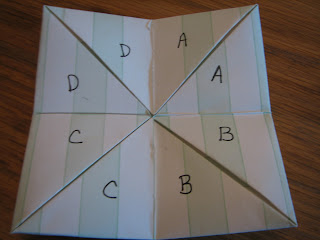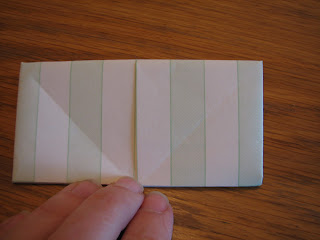Turtle, Turtle, Watch Out! follows one sea turtle from egg to egg-laying mother, through challenge after challenge, some man-made, some the natural order of things.
follows one sea turtle from egg to egg-laying mother, through challenge after challenge, some man-made, some the natural order of things.
This story and activity could be used in any number of units: the ocean, animals, predator/prey relationships, human impact on nature, etc.
Begin the lesson by reading the story aloud to the students. While they're listening, have them write down challenges the turtles face as well as the good things that happen that aid the turtle's survival. Or maybe you'll want to read the story twice - the first time just for listening, the second time for taking notes. As a class, you can brainstorm additional items to add to each list, if you desire.
Next, each student will make a cootie catcher. If you or your students are familiar with making these, I've included directions at the bottom of the lesson.
This story and activity could be used in any number of units: the ocean, animals, predator/prey relationships, human impact on nature, etc.
Begin the lesson by reading the story aloud to the students. While they're listening, have them write down challenges the turtles face as well as the good things that happen that aid the turtle's survival. Or maybe you'll want to read the story twice - the first time just for listening, the second time for taking notes. As a class, you can brainstorm additional items to add to each list, if you desire.
Next, each student will make a cootie catcher. If you or your students are familiar with making these, I've included directions at the bottom of the lesson.
Label the inside of your cootie catcher as shown:
Now, pick 8 items from your lists - 4 from the list of challenges, 4 from the list of "good things".
Open the flaps of your cootie catcher and write one item under each letter. The order in which you write them can be completely random.
You'll also need to make a simple mat (one for the class) - use the following picture as a guide - and get a die.
Now you're ready to play.
To being with, everyone needs to stand up - everyone is a thriving baby turtle.
The teacher, or other designated party, rolls the die onto the mat. Each student manipulates his/her cootie catcher the number of times indicated by the die. Then the students read the message under the letter that corresponds to the letter the die landed on.
Students whose message is a challenge or threat to the turtle sit down - they haven't survived. Students who receive a message of a "good thing" remain standing.
The students who remain standing play another round in the same manner. Try to play 5 rounds, or see how many rounds it takes for all students to be sitting.
Baby sea turtles face a lot of challenges in making it to adulthood, as do many other animals. Hopefully this fun game helps your students understand just how few babies survive to adulthood and encourages them to think about the impact of their actions on other species.
To Make a Cootie Catcher
Begin with a square piece of paper. (I cut 8.5x11" paper into a square).
Fold the square in half along the diagonal.
Unfold. Fold in half along the other diagonal.
Unfold. You'll have a square piece of paper, with the fold lines making an X across it.
Pick one corner of the square, and fold it, so the point is at the center of the X.
Fold in each of the additional corners of the square.
Turn your newly formed square over.
Repeat the previous step, folding each point into the center of the square
Turn your newly formed square over.
Repeat the previous step, folding each point into the center of the square
Label the sections, as directed above.
Fold the cootie catcher in half, to make a rectangle.
Place both your thumbs and index fingers under each flap to work the cootie catcher.
*****
This activity is adapted from "Turtle Hurdles," published in Picture-Perfect Science Lessons by the National Science Teachers Association.











